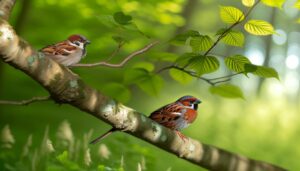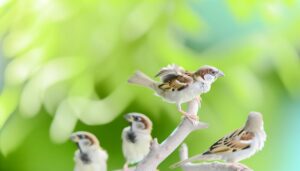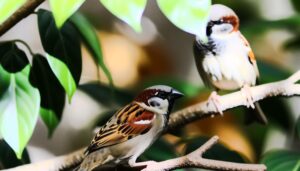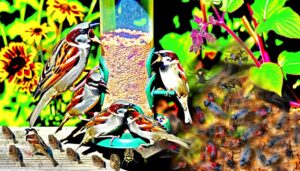7 Key Differences Between House Sparrows and Tree Sparrows in Scotland
House Sparrows (Passer domesticus) and Tree Sparrows (Passer montanus) exhibit distinct physical characteristics. The House Sparrow is larger with a grey crown and black bib, while the smaller Tree Sparrow has a chestnut-brown crown and black cheek spots.
House Sparrows primarily inhabit urban regions, nesting in human-made structures, whereas Tree Sparrows favor rural areas, utilizing tree cavities and nest boxes. Behaviorally, House Sparrows form large flocks and exhibit aggressive behavior, while Tree Sparrows are seen in smaller, more reserved groups.
These differences in habitat, morphology, and behavior are essential for understanding their ecology and aiding in conservation efforts. Discover more nuanced distinctions and the significance of their conservation.
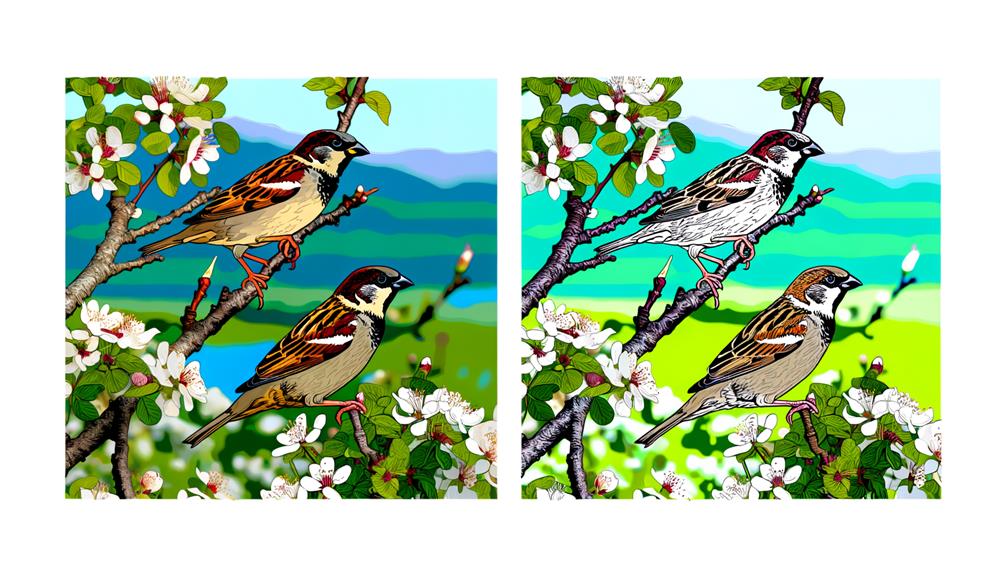
Key Takeaways
- House Sparrows have grey crowns and black bibs, Tree Sparrows have chestnut-brown crowns and black cheek spots.
- House Sparrows thrive in urban areas, while Tree Sparrows prefer rural woodlands and farmlands.
- House Sparrows are aggressive and form large flocks; Tree Sparrows are more reserved and seen in smaller groups.
- House Sparrows mainly eat grains and food scraps; Tree Sparrows consume seeds and insects.
- Conservation efforts include habitat restoration, nest box programs, and citizen science projects to monitor and support populations.
Physical Differences
The House Sparrow (Passer domesticus) and the Tree Sparrow (Passer montanus) exhibit distinct physical differences that facilitate their identification and study.
The House Sparrow is generally larger, with males displaying grey crowns, black bibs, and chestnut-brown napes, while females and juveniles exhibit more subdued, brownish tones.
In contrast, the Tree Sparrow is smaller and more uniformly patterned, with both sexes featuring chestnut-brown crowns, distinctive black cheek spots, and a neater appearance.
The Tree Sparrow's smaller size and more consistent coloration make it easily distinguishable from the more robust and variably colored House Sparrow.
These morphological distinctions are essential for ornithologists and bird enthusiasts in field identification and ecological studies, providing a reliable means of differentiating these sympatric species.
Habitats and Distribution
House Sparrows exhibit a cosmopolitan distribution, thriving in urban and suburban environments across a wide range of geographical regions. They are highly adaptable, often found nesting in human-made structures.
In contrast, Tree Sparrows prefer rural settings, favoring woodlands and farmlands. Their nesting sites are generally located in tree cavities or nest boxes provided in conservation efforts.
Key differences in habitats and distribution include:
- Urban vs. Rural: House Sparrows are urban dwellers, while Tree Sparrows inhabit rural landscapes.
- Nesting Sites: House Sparrows utilize buildings, whereas Tree Sparrows select natural tree cavities.
- Conservation Status: Tree Sparrows have faced population declines in some regions, prompting targeted conservation measures.
These distinctions highlight their differing ecological preferences and adaptability.
Behavior and Diet
Both species exhibit distinct behavioral patterns and dietary preferences that reflect their adaptation to different environments. House Sparrows (Passer domesticus) are highly social, often forming large flocks and exhibiting aggressive behavior to secure food resources. Their diet mainly consists of grains, seeds, and food scraps, making them well-suited to urban areas.
In contrast, Tree Sparrows (Passer montanus) display a more reserved social structure, typically seen in smaller groups. They primarily consume seeds but also include insects in their diet, especially during the breeding season. This dietary flexibility allows them to thrive in both rural and semi-urban habitats.
These behavioral and dietary distinctions underscore the ecological niches each species occupies, highlighting their respective adaptive strategies.
Breeding and Nesting
Breeding and nesting habits of House Sparrows and Tree Sparrows exhibit distinct differences that are key to understanding their reproductive strategies. House Sparrows prefer urban environments, often nesting in man-made structures, while Tree Sparrows favor rural settings, nesting in tree cavities or nest boxes.
Key differences include:
- Nest Location: House Sparrows often choose buildings or other structures, whereas Tree Sparrows select natural cavities.
- Clutch Size: House Sparrows typically lay 3-6 eggs per clutch, whereas Tree Sparrows lay 4-6 eggs.
- Breeding Season: House Sparrows have a longer breeding season, from early spring to late summer, while Tree Sparrows have a more constrained period, usually from late spring to mid-summer.
These distinctions highlight their unique adaptations to their respective environments.
Conservation Efforts
Conservation efforts for House Sparrows and Tree Sparrows are necessary due to their declining populations, driven by habitat loss and other environmental pressures.
Initiatives include habitat restoration, such as planting native vegetation and creating insect-friendly gardens, which provide essential food resources.
Nest box programs also support breeding, especially in urban areas where natural nesting sites are scarce.
Monitoring populations through citizen science projects helps track changes and informs adaptive management strategies.
In addition, reducing pesticide use protects their food sources from contamination.
Collaboration between conservation organizations, governmental bodies, and local communities is crucial to implement these measures effectively.
Continuous research is necessary to understand the specific needs of each species and adapt conservation strategies accordingly, ensuring their long-term survival.
Conclusion
To sum up, the house sparrow and tree sparrow, though sharing similarities, exhibit distinct physical traits, habitats, behaviors, diets, and breeding practices.
Conservation efforts are vital, as these species face environmental challenges. 'A stitch in time saves nine' aptly illustrates the importance of timely intervention to preserve their populations.
Thorough understanding and targeted actions can mitigate risks, ensuring the continued coexistence of these avian species within their respective ecosystems.

